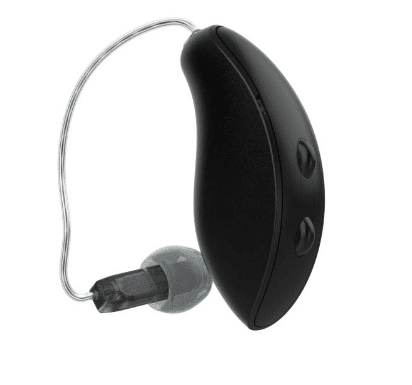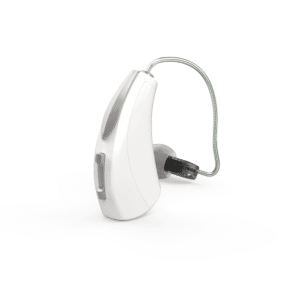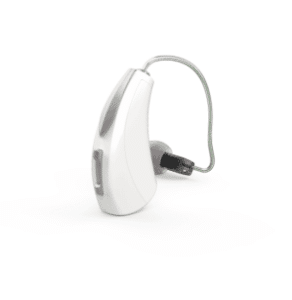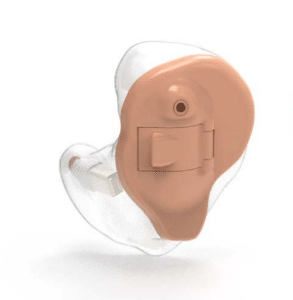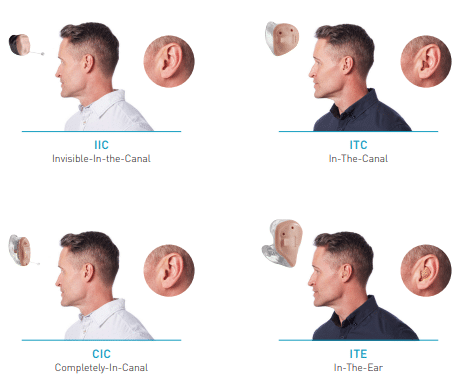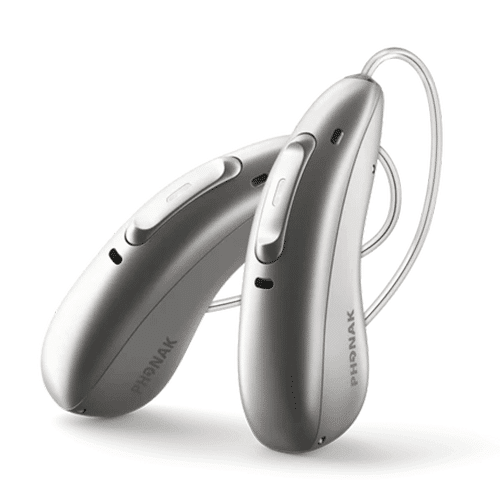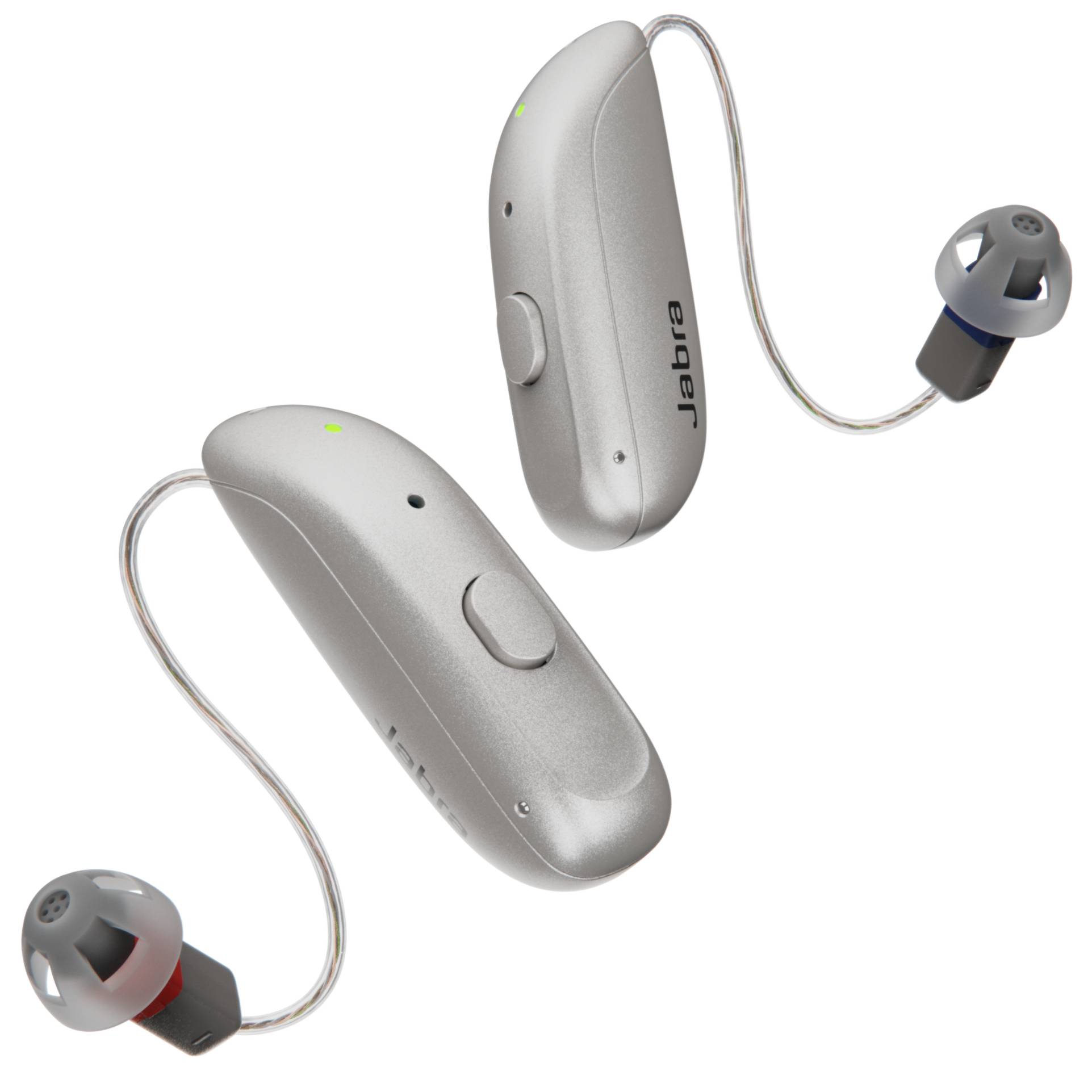- Cost: $2,365-$5,945 per pair
- Styles: Receiver-in-canal (RIC), micro RIC (mRIC), in-the-ear (ITE), in-the-canal (ITC, sometimes referred to as half-shell or HS), completely-in-canal (CIC), invisible-in-canal (IIC)
- Type of hearing loss: Mild to severe
- Battery type: Rechargeable or disposable
- Bluetooth streaming: Yes, in select models
Starkey Hearing Aids Review 2025: Our Experts Tested Advanced Features
Key Takeaways
- Starkey hearing aids are prescription devices designed to treat mild to severe hearing loss or one-sided hearing loss. You must purchase them through a licensed hearing professional.
- The Genesis AI is the latest model offering 51 hours of battery life and brain-like neural processing software to deliver clear sound.
- Pricing varies between retailers, models, and technology levels. Generally, Starkey hearing aids cost $2,365–$5,945 per pair.
- Insurance companies rarely cover hearing aids in full. Ask your hearing care provider about financing options, discounts, or financial resources to help you afford treatment.
Shopping for hearing aids can be a confusing process. With so many options in hearing aid brands, styles, and technologies, it’s hard to know which device is the right investment for you.
We researched the top hearing aids in the industry and awarded Starkey Evolv AI (artificial intelligence) “Best with Fall Detection.” In addition to the Evolv AI, Starkey recently unveiled its latest Genesis AI model with more up-to-date features, including advanced sound processing technology that is rare in the hearing aid industry.
This Starkey hearing aid review provides an in-depth look into the brand’s current prescription models (Starkey hearing aids are only available with a prescription), pricing, features, and accessories. We hope consulting with your audiologist and reading the following information will help you decide if this brand is right for you.
Starkey hearing aids offered in 2025
Starkey has three current prescription hearing aid models, each with its unique set of features and styles. All models are available in different technology levels depending on your needs and budget.
Keep reading to learn more about Starkey and its high-tech product lines.
Why you can trust our expert review
Our team recommends products and services that we believe provide value in the lives of our readers. We’ve spent more than 5,000 hours conducting in-depth research on hearing aid devices to give you the most accurate hearing aid review. To make these selections, we:
- Consulted with audiologists
- Mystery shopped 18 brands
- Surveyed hundreds of hearing aid users
- Tested various models of hearing aids
- Interviewed experts in the field
- Read thousands of verified customer reviews
Read more about our hearing aid review methodology.
Why Starkey is one of our top picks
Starkey is one of our top hearing aid brands due to its innovative technology that helps people hear better and monitor their overall health.
Starkey Evolv AI and Genesis AI both offer fall detection using built-in sensors, which can alert a loved one or caregiver of your choice in case of an emergency. Hearing aids typically don’t have fall detection, so this is a unique feature. The Consumer Technology Association also honored the Evolv AI for its noise reduction technology, providing clearer sound to the wearer through the use of artificial intelligence.
While Starkey does offer high-tech models, its selection is scarce compared to brands like Phonak and Signia, which offer more than three options. And although Starkey treats all levels of hearing loss, it doesn’t offer much choice for those looking for profound or severe hearing loss solutions. The Evolv AI is the only model that treats profound hearing loss, while Signia, for example, offers three models that do so.
Pros and cons of Starkey hearing aids
Table 1 Compare Starkey hearing aids, as of 2025
|
Genesis AI
Visit Site
|
Evolv AI
Visit Site
|
Picasso
Visit Site
|
|
|---|---|---|---|
| Cost per pair | $2,365–$5,945 | $2,365–$5,945 | $2,598–$4,598 (varies by retailer) |
| Styles | RIC, ITE, ITC, CIC, IIC | BTE, RIC, ITE, ITC, CIC, IIC | ITE, ITC, CIC, IIC |
| Battery type | Rechargeable or disposable | Rechargeable or disposable | Disposable |
| Bluetooth streaming | Yes* | Yes* | No |
| Customization | Yes | Yes | Yes |
| Water resistant | Yes | Yes | Yes |
| Telecoil | Yes* | Yes* | Yes* |
| Directional microphone | Yes* | Yes* | Yes* |
| Noise reduction | Yes | Yes* | Yes* |
| Processing channels | 12–24 | 10–24 | 10–24 |
*Available in select styles, models, or technology levels
Starkey hearing aid models
How to adjust your Starkey hearing aids
The newer Genesis AI and Evolv AI hearing aids use the My Starkey and Thrive apps, respectively, for minor sound adjustments during day-to-day use.
Some hearing aids, like the Genesis AI and Evolv AI RIC styles, let you program three different features directly on the hearing aid. A hearing professional will help you program these at your fitting appointment when you’re trying on your hearing aids for the first time. ITC sizes or larger have a wheel or button allowing you to manually switch between features or adjust volume without the app. For all of the other features, you’ll need to use the Starkey app.
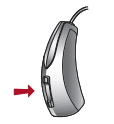
Use the buttons on the body of the hearing aid to switch between three features of your choice.
If you don’t always want to use your phone, or if you have a small CIC that is accessory-compatible, you can also purchase a StarLink remote control for $373. Remote controls have similar manual controls to the ones found on the larger hearing aids, but the buttons are larger and easier to use if you have dexterity issues from conditions like arthritis.
Both My Starkey and Thrive apps offer TeleHear for larger adjustments. This feature allows you to schedule a virtual appointment over video chat with a Starkey hearing professional. They can help troubleshoot any issues you may be experiencing, and if they need to adjust your hearing aids professionally, they can do so remotely through the app.
Picasso is an older model, so it lacks many of these advanced technical features. The larger ITE and ITC styles have volume wheels or buttons for control, similar to the Genesis and Evolv models. But the smaller CIC and IIC models need the SurfLink remote accessory to adjust the volume. Because Picasso isn’t Bluetooth-enabled, you won’t have access to an app for any adjustments, even from a professional. You must visit your local hearing clinic for assistance.
About Starkey
In 1967, William Austin founded Professional Hearing Aid Service in Minnesota. His business didn’t become Starkey until four years later when he bought an earmold company called Starkey Laboratories. Starkey Laboratories has evolved into a global brand, establishing the Starkey Hearing Foundation, which trains hearing care professionals in developing countries. Despite its global reach, Starkey headquarters remains in Eden Prairie, Minnesota.
Today, Starkey offers prescription hearing aids that use advanced technology like artificial intelligence to improve hearing for those with hearing loss. You can only purchase these devices through licensed hearing care professionals at your local clinic or through provider networks like Yes Hearing.
How much do Starkey hearing aids cost?
Starkey hearing aids cost between $2,365–$5,945 per pair, depending on your hearing care provider, the model, and the technology level. Genesis AI and Evolv AI hearing aids offer solutions for one-sided hearing loss, which costs $1,950 for the specific technology, plus the cost of a single hearing aid on the opposite ear.
How to pay for Starkey hearing aids
Starkey hearing aids are by prescription only, so you must purchase them from a licensed hearing care professional. Payment options vary by provider; ask about accepted forms of payment before you book your appointment.
You could consider purchasing your prescription hearing aids through discount networks like Yes Hearing, which offers hearing aids for up to 40% less than the retail price. You can purchase through this network by booking a free virtual consultation with a local Yes Hearing licensed professional, who will guide you through the process.
Insurance Coverage
Insurance coverage varies between plans and states. If you have private insurance, call your insurance provider or ask your hearing clinic to verify your benefits.
Medicare usually doesn’t cover hearing aids, but it varies. Original Medicare (Part A) does not typically approve hearing aid coverage, but Medicare Plan B may cover an initial examination if deemed medically necessary by your doctor. Medicare Advantage (Part C) is most likely to cover a portion of hearing aid costs when medically necessary, but not all plans offer this benefit. Similar to private insurance, hearing aid coverage depends on the specific plan and your location, so make sure you verify your benefits with your insurer.
Medicaid beneficiaries may have coverage depending on the state. The Hearing Loss Association of America lists each state’s Medicaid laws on hearing aid coverage, but call your local Medicaid office to verify your benefits.
And if you’re a veteran, you may be eligible for coverage through the Veterans Affairs (VA) health care system. Contact your local VA medical center to check your eligibility.
Financing
If you’re purchasing through an audiology clinic, ask about financing options to reduce the upfront cost. Each clinic may offer different terms, so ask about payment plans and how to apply.
Discount networks may list financing options online. Yes Hearing offers financing services through three partners (Affirm, CareCredit, and Allegro Credit), with term lengths ranging between three and 48 months. Note your term lengths and interest rates depend on your approval, but you can prequalify to determine eligibility before the purchase process.
Flexible savings accounts (FSA) and health savings accounts (HSA)
Some employers offer an option to contribute to an FSA or HSA. When you contribute to either type of account, you allot part of your pre-tax income for out-of-pocket medical expenses. An HSA will gather interest and roll over into the next year, but an FSA will not.
You can use funds in either account to pay for hearing aids if necessary. If you’ve enrolled in an FSA or HSA, you should have a debit card for the account you can use at checkout for eligible expenses. Check with your retailer on whether it accepts payment from either account.
How to save money on Starkey hearing aids
Prescription hearing aids can cost several thousands of dollars, but there are resources available to help you save when insurance coverage and financing offer little help. Check NCOA BenefitsCheckUp® for benefits specific to your area.
Starkey Neighbors in Need Program
Starkey hosts a charitable organization called Neighbors in Need, which helps those in low-income households gain access to hearing aids.
Email neighborsinneed@starkey.com or call 855-686-2202 to find out if you qualify. Note there is a $300 application fee, but you only pay the fee if you qualify, and that is the only cost you will pay.
Hearing Aid Donation Programs
Look into organizations like the Lions Club and the Hearing Aid Project, which refurbish donated hearing aids for reuse. You can fill out an online application to see if you qualify for free hearing aids.
State Vocational Rehabilitation Programs
Some states offer free hearing aids when you participate in vocational rehab, a program that helps you perform your job or hone your skills to get a new job. Contact your state agency to see how you can enroll, or if you’re already enrolled, ask how you can apply for access to hearing aid assistance.
Ask about over-the-counter (OTC) options
If you have mild to moderate hearing loss, you may be able to treat it with OTC hearing aids instead of prescription hearing aids. In general, the best OTC hearing aids cost between $99–$2,998 per pair. But they do have limitations. Most OTC hearing aids don’t have prescription technology that can treat complex forms of hearing loss or make fine-tuned adjustments to incoming audio. Don’t settle on an OTC brand just to save—talk to your audiologist first. You may end up purchasing a device that doesn’t help, costing you more in the long run when you have to replace it with a more appropriate prescription brand.
Starkey smartphone apps
Starkey offers the My Starkey and Thrive apps (depending on your hearing aid model) to help you adjust your hearing aids, track your health, and contact support. It also offers three optional apps that may be useful, depending on your needs: Hear Share, Our Relax, and SoundCheck. All apps are available through the App Store or Google Play at no cost.
My Starkey
Bluetooth-enabled Genesis AI hearing aid models use the My Starkey app for small adjustments and health tracking. It also provides a section with resources to help you learn the app’s functions and to care for your hearing aids properly.

From your hearing settings, you can activate the DNN to clarify incoming sounds by selecting Edge Mode+, or you can make your own adjustments, like increasing volume. You can also choose hearing programs, sometimes known as “memories,” which are personalized hearing settings for different environments, like eating at a restaurant or hiking outdoors. When you select a program, your hearing settings will automatically adjust to help you listen better in the environment you’re in. Your licensed hearing professional will help set these programs up for you.
The health section of the app features a dashboard of your daily step count, standing time, and exercise time to help you track your activity. You can also explore your social health by selecting the weekly hearing report, which tells you how many hours you’ve used your hearing aids and how often you’ve engaged with others.
The My Starkey app also has some surprising features. The fall alert feature will text a contact of your choice if it detects a fall. If your hearing aids falsely detect a fall, or if the fall wasn’t serious enough to need help, you can cancel the alert before it’s sent. You can customize detection sensitivity, countdown time before sending an alert, and your preferred contact by going to More > App settings > Fall alert settings. Unsure if this feature benefits you? Screen your falls risk using the NCOA Falls Free CheckUp.

You can even translate up to 25 different languages using the app’s translation tool. Use the tool by selecting the language you speak and the language you’re translating. Press the microphone button on the screen to record your voice, and the app will translate it.
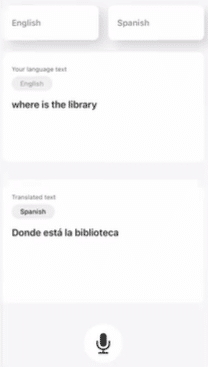
And if you ever need assistance troubleshooting issues with your hearing aids, you can schedule a virtual appointment with a licensed hearing care provider through the TeleHear feature. Find this in your app by selecting More > TeleHear.
Visit the My Starkey app tutorial page for how-to videos and more information on its features.
Thrive Hearing Control
Also known as Thrive, this app helps you control Bluetooth-enabled Evolv AI hearing aids, and is the predecessor of the My Starkey app.
Thrive serves as the foundation of the My Starkey app, so it has many of the same features, including activity monitoring, engagement tracking, language translation, fall alerts, and TeleHear. The app has an Edge Mode, although its automatic adjustments are less advanced because Evolv AI and Livio hearing aids don’t have the DNN. You’ll also find Mask Mode, which is an outdated feature according to a Starkey research study on AI and its improved speech clarification capability.1
When we tested Evolv AI hearing aids with an iPhone, the app connected to the hearing aids almost immediately after they paired with the phone’s Bluetooth. Adjustments were easy, and we liked how you could select custom memories (or programs) with preset settings for different environments. We also liked that you can access important documents for reference, including the user guide and operations manual.

Hear Share
The Hear Share app is an optional app that helps caregivers and family members monitor the hearing aid wearer. The hearing aid user chooses which information appears on Hear Share for others to see, like health tracking and device connection status. It’s compatible with Genesis AI, and Evolv AI hearing aids.
This app is a great tool for loved ones who want to ensure the devices are working properly as the user remains independent with day-to-day activities.
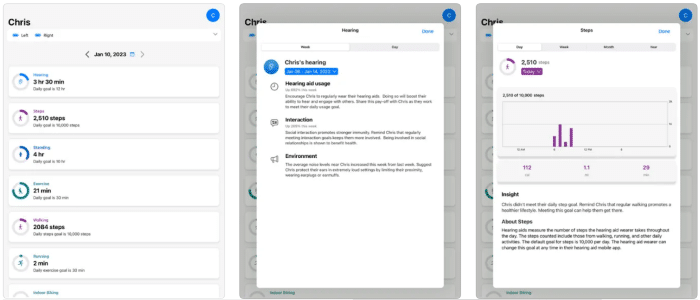
Starkey Relax
The Starkey Relax app provides relief to those diagnosed with tinnitus, or ringing in the ears. You get 12 different sounds that integrate with your hearing professional’s sound therapy protocol to provide relief and decrease symptoms over time. You can also make your own minor adjustments to best provide relief for your specific condition.
You can play the sounds through your hearing aids if Bluetooth-enabled, or remove your hearing aids and listen through a headset. You should be somewhere quiet for the best results.

SoundCheck
The Starkey SoundCheck app helps you screen your own hearing for deficits or to check ambient noise levels. Although this app is potentially useful, it has a 2.2 out of 5 star rating on the App Store and it hasn’t been updated since 2019.

Instead, the team recommends taking the online hearing screen through the Starkey website (see next section for details). And if you’d like to download a highly rated app that checks noise levels around you, download Decibel X:dB Sound Level Meter through the App Store, or the Decibel X – Pro Sound Meter through Google Play.
Online hearing test
Starkey offers a free online hearing test that helps you screen for hearing loss at home. It takes about five to 10 minutes and does not collect personal information.
First, you must answer a few questions about your symptoms. Starkey asks if you have trouble hearing in different situations, like watching TV or listening to conversations in a crowded room.
Next, the test prompts you to find a quiet room, put on a headset or earbuds, and set your volume to about 70% intensity. You’ll calibrate your lowest and highest hearing volume on each ear. Once you’re set up, the test plays tones at different volumes to determine the softest tones you can hear at various pitches and frequencies in each ear.
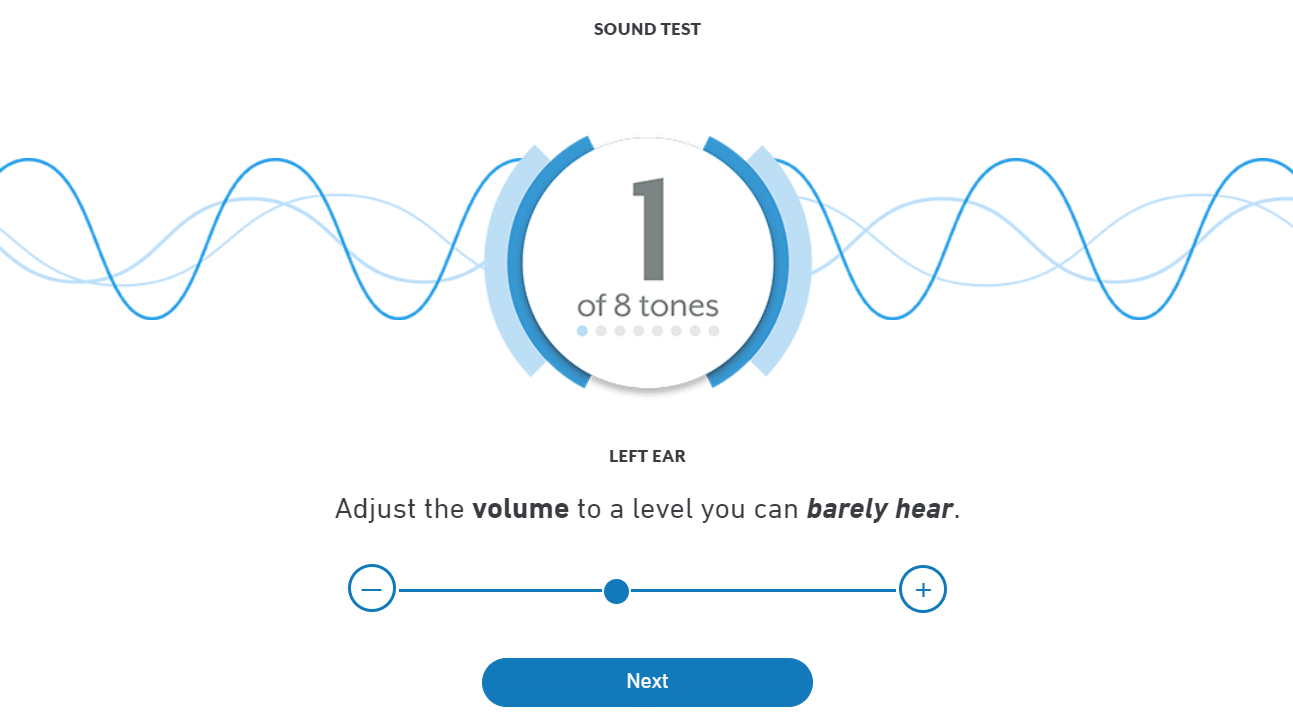
After you’ve completed the sound test, you move on to the speech test. Listen carefully for a word in the midst of the background noise. When you hear a word, you must select it from four choices that sound similar to each other. It’s trickier than you might think.

You’ll receive your results immediately after the hearing test. If your results are consistent with any level of hearing loss, it will suggest you follow up with a hearing professional.

Remember, online hearing tests do not replace an audiologist’s in-depth evaluation. An audiologist can determine the cause of your hearing loss and whether hearing aids are an appropriate treatment. An online hearing screen is a good place to start, but you should always see an audiologist for a full exam, especially if you’re having trouble hearing during day-to-day activities.
Starkey accessories
Many Starkey accessories are specific to models and styles, including chargers.
Other accessories, like remote microphones, pair with your hearing aids so you can listen better and control incoming sound in different environments.
Read below to find out which accessories are appropriate for each Starkey hearing aid.
Chargers
Starkey offers two types of chargers: standard and premium. Standard chargers need to be plugged into power during use, while premium chargers are portable.
The original standard and premium chargers are compatible with the Evolv AI. Both chargers take about three-and-a-half hours to fully charge your hearing aids.
Genesis AI hearing aids require a new generation of accessories called StarLink. Genesis AI mRIC and RIC hearing aids are compatible with StarLink standard and premium chargers. They’re mostly similar to the original chargers, but these come with built-in turbo charging, which provides up to three hours of battery in only seven minutes of charge. After seven minutes, it will slow down to normal charging speed, which fully charges your hearing aids in three-and-a-half hours.
If you want turbo charging but you have the original standard and premium chargers, you can purchase a mini turbo charger as its own unit. It has the capacity to fully charge hearing aids up to four times before depleting its own battery. Note it’s only available for RIC and BTE models.
If you have custom ITE or ITC hearing aids, you’ll need a custom standard or premium charger made to fit your molds. The charging times are the same, but you won’t have a turbo charging option—even if you have the Genesis AI model.
We contacted a local retailer, who quoted $130 for original and custom chargers, and $150 for the mini turbo charger unit.
Accessories
Unlike chargers, StarLink accessories are almost universal—meaning they can be used with almost all Starkey models. They’re compatible with Genesis AI models (RIC, mRIC, ITE, and ITC styles), Evolv AI models (all styles), and Livio models (all styles). Unfortunately, they are not compatible with the Picasso model.
StarLink accessories are a good option if your older smartphone (check for iPhone and Android compatibility) cannot support your hearing aid technology or its app. Choose between any of the following accessories to improve your hearing experience. Note pricing may vary by retailer, but general pricing ranges between $373–$623 per unit.
- Mini remote microphone: Clips onto your shirt to pick up one-on-one conversations in crowded places, then sends the audio to your hearing aids
- Remote microphone +: Functions similarly to the mini remote microphone, but can access various audio sources like Bluetooth or telecoil
- Table microphone: Functions similarly to the microphones above, but can capture sound in busier environments like a dinner outing or a work meeting
- Remote control: Allows you to make quick adjustments like changing volume or switching between programs
You can also opt for a StarLink TV streamer, which plugs into your TV to send sound directly to your hearing aids. This allows you to hear the TV’s audio clearly without making the volume too loud for others in the room.
All Picasso hearing aid styles use an older generation of accessories labeled SurfLink. You have the choice of four different products:
- Media 2: Plug into your TV or radio to stream audio directly into your hearing aids
- Remote microphone 2: Clips onto your shirt to better pick up one-on-one conversations in crowded places, then sends the audio to your hearing aids
- Remote: Allows you to make quick adjustments like changing volume or switching between programs
- Mini mobile: Pair your Bluetooth-enabled smartphone to this device to stream phone calls to your hearing aids
Not every retailer carries the Picasso model and its accessories since it is an older model. Again, prices will vary between retailers.
Warranty, maintenance, and care
Your Starkey hearing aids should come with a warranty covering maintenance, repairs, and replacements for a period of time. Your warranty length and returns policy depend on the retailer. If you’d like to purchase a warranty plan on your hearing aids (even non-Starkey devices), you can purchase a Worry-Free Warranty through your local audiologist. Pricing varies depending on your clinic.
You can avoid preventable repairs by maintaining and caring for your hearing aids properly. Your hearing aids should come with a cleaning kit, which is equipped with cleaning tools and an eight-pack of replacement wax guards. Clean your hearing aids weekly using a dry cloth or the cleaning brush in your kit, and remember to replace your wax guards monthly. It may be a good idea to schedule a professional cleaning every six months to remove stubborn dirt and grime.
Even if your hearing aids are water-resistant, you still want to avoid heat and moisture as they may damage the device’s circuitry—always store your hearing aids in a cool, dry place. You could invest in a dehumidifying storage container to remove moisture from your hearing aids when you’re not using them. On Amazon, dehumidifier accessories start at around $20–$30.
Starkey support and customer service
Starkey has an entire support section on its website dedicated to providing you with resources. You’ll find information on various topics, like troubleshooting your hearing aids or reading warranty details.

You can also browse tutorial videos, which demonstrate how to pair your hearing aids to your phone, use your Starkey and Thrive Hearing Control apps, and operate your devices properly.
If you need additional support, contact a customer service representative via phone, online chat, or online form.
- Phone: 888-481-5512, Monday through Friday from 8:30 a.m. to 5:30 p.m. CT
- Online chat: Click on the bottom right icon on the Starkey website for access
- Online form: Fill out this contact form to receive an email or call-back from an agent
At first, online chat uses an automated system to answer your query. You can get a live agent by following the prompts until it asks if you need anything else. Answer yes, and it will direct you to a real person.

Starkey hearing aid customer reviews
We read online reviews from Better Business Bureau (BBB) and Trustpilot to understand what customers thought about Starkey’s hearing aids.
On Trustpilot, Starkey has a 3.1 out of 5 star rating, with 342 reviews. Just under 60% are four or five stars. On BBB, the brand has an A+ rating and only 1 out of 5 stars, but there are only six reviews to bolster the rating. Reviews are as of July 2023.
Positive reviews praise Starkey for its life-changing technology. Its hearing aids’ ability to enhance hearing in various environments is a common theme across multiple reviews.
Negative reviews reference issues controlling feedback noise or poor customer experience during a repair under warranty.
Starkey is active on both sites, responding to positive and negative customer reviews and acknowledging concerns with thoughtful answers. For example, one three-star review stated the new update to Android and Samsung phones automatically connected the hearing aids to Bluetooth, which caused issues while answering calls. Starkey responded with links to resources and suggested actions, like updating the app or re-pairing the devices with the app. It also included a phone number to call if none of the suggestions worked.
Customer reviews
“The hearing aids require little to no maintenance, and are very easy to insert. I am hearing sounds I never even knew existed, like the ticking of the clock in my study, the sound of my car’s direction indicators (were forever leaving them on), and the voice of the waitress in a crowded restaurant. I can even hear the sound of the wind in the trees and the birds in early morning. I have missed out on so much, I can not wait for my first visit to the sea with them, I will be able to hear the smallest waves.”
EUGENE, VERIFIED CUSTOMER (Trustpilot)
“Very disappointing experience with the Starkey Livio hearing aids. Haven’t had them for two years and have been supposedly fixed. The right one now is not working again. The company doesn’t appear to care about the customer’s experience.”
JOHN, VERIFIED CUSTOMER (BBB)
“Recently replaced my 5+ year old Starkey hearing aids with a new pair of Starkey hearing aids. What a difference! My best indication of just how much difference is the number on the TV volume control. I was cranking up the volume to somewhere between 30 and 40, and with the new hearing aids I can hear the TV better at something below 20 … conversations are also much easier to follow now.”
DALE, VERIFIED CUSTOMER (Trustpilot)
Who are Starkey hearing aids for?
Starkey offers prescription hearing aids for people with mild to profound hearing loss. It also offers treatment options for those with single-sided hearing loss. Genesis AI and Evolv AI RIC or BTE hearing aids have contralateral routing of signal (CROS) and bilateral contralateral routing of signal (BiCROS) technology to help treat this condition when traditional hearing aids are not appropriate.
Those who would benefit from a BiCROS system have hearing loss in both ears, but one side is more affected than the other. Reisman explained the transmitter is placed on the most affected side, while the hearing aid and receiver are placed on the less affected side.
Reisman also explained how CROS systems work. A person wears a transmitter on the ear with hearing loss, or the affected side. The hearing aid receiver goes on the ear without hearing loss, or the unaffected side. The transmitter on the affected ear sends incoming sound to the hearing aid receiver in the unaffected ear, allowing the wearer to hear audio from the affected side.
Research shows CROS systems are effective in improving speech understanding, even in environments with background noise. But, they’re not helpful in improving sound localization (the ability to tell where sound is coming from). You should remain alert in busy places; improved sound clarity is helpful, but it won’t always help you decipher the direction the sound is coming from.2
A Starkey hearing aid unit with the CROS/BiCROS system is $1,925 for the transmitter, plus the cost of a single hearing aid on the other ear. Talk to your audiologist about Starkey CROS/BiCROS systems if you have more hearing loss on one side compared to the other.
Starkey vs other brands
Here’s how Starkey compares to other brands in our article ranking the best hearing aids on the market.
Although Jabra Enhance OTC hearing aids have significantly lower prices, they treat a narrow window of hearing loss, with fewer available styles. Higher-priced Starkey models are about $600 less than Phonak and Oticon, with Oticon offering similar DNN technology and high-speed processing for clearer sound.
Table 2 Comparing Starkey to other brands, as of 2025
|
Starkey
Visit Site
|
Phonak
Visit Site
|
Oticon
Visit Site
|
Jabra Enhance
Visit Site
|
|
|---|---|---|---|---|
| Cost per pair | $2,365–$5,945 | $2,475–$6,545 | $2,150–$6,550 | $799–$1,995 |
| Type of hearing aid | Prescription | Prescription | Prescription | OTC |
| Type of hearing loss | Mild to profound | Mild to profound | Mild to profound | Mild to moderately severe |
| Styles | RIC, BTE, ITE, ITC, CIC, IIC | RIC, BTE, ITE, IIC | BTE, RIC, ITE, ITC, CIC, IIC | RIC, ITE |
What to consider when shopping for hearing aids
While hearing aids can be costly, they are life-changing investments to your health. According to the National Institute on Deafness and Other Communication Disorders, only one-third of adults who need hearing aids have used them.3 Yet untreated hearing loss can have profound effects on your social and mental health. Research shows a link between hearing loss and feelings of isolation and loneliness, which can lead to depression and cognitive decline.4
When shopping for hearing aids, make sure you purchase what you need. Get a full examination from an audiologist to understand your hearing loss and proper treatment. Discuss all your options with your audiologist, including cost-effective solutions, that can help you hear better and improve your quality of life.
Bottom Line
Starkey offers three models of prescription hearing aids ranging between $2,365–$5,945 per pair: Genesis AI, Evolv AI, and Picasso.
All hearing aids are appropriate for those with mild to severe hearing loss, and only select Evolv AI devices can treat profound hearing loss. Starkey also offers CROS and BiCROS options in the Genesis AI and Evolv AI models for people with one-sided hearing loss. And if you prefer custom hearing aids, Starkey offers custom ITE, ITC, CIC, and IIC styles.
Pricing, financing, and warranty terms vary among retailers, but discount provider networks like Yes Hearing offer hearing aids for up to 40% off the retail price. Consider financing or exploring local programs for financial assistance.
Frequently asked questions
The answer depends on your preference of how the hearing aid processes sound. Both brands offer similar technology and treat the same levels of hearing loss, but have different philosophies behind managing background noise and processing speech. For example, Starkey sounds sharper in high frequencies, while Phonak sounds softer. One is not better than the other, but one might be more comfortable for you.
Starkey offers award-winning devices that use brain-like technology to optimize your sound profile to your surroundings. More than 60% of Trustpilot reviews are positive, reporting life-changing results from wearing Starkey hearing aids.
Starkey offers three models of prescription hearing aids, ranging between $2,365–$5,945 per pair: Genesis AI, Evolv AI, and Picasso. CROS/BiCROS systems cost $1,925 for the transmitter, plus the cost of a single hearing aid on the other ear.
The most expensive Starkey hearing aids are the Genesis AI and Evolve AI models, which offer the clearest sound due to their advanced sound processing technology. These options cost $5,945 per pair.
Starkey reports that a five-year lifespan is typical for its hearing aids.
The Genesis AI RIC style has a battery life of 51 hours. Genesis AI mRIC and ITC styles last 41 and 36 hours, respectively. Evolv models last about 24 hours.
Yes, Starkey hearing aids are made in the United States, although the brand has expanded its reach globally. The main headquarters is located in Eden Prairie, Minnesota.
Your hearing aids should come with a cleaning kit, equipped with cleaning tools and an eight-pack of replacement wax guards. Clean your hearing aids weekly using a dry cloth or the cleaning brush in your kit, and remember to replace your wax guards monthly. It may be a good idea to schedule a professional cleaning every six months to remove stubborn dirt and grime.
For RIC and BTE hearing aids, place the body of the hearing aid behind your ear, and the receiver, or the end of the wire, into your ear.
Smaller styles may be custom-made to your ear, but the process is the same for everyone. Insert the earpiece into your ear canal, twist it backward, and press gently to secure its position.
Have questions about this review? Email us at reviewsteam@ncoa.org.
Sources
- Fabry, Dave and Burns, Thomas. Edge Mode: Unmasking Benefits for Hearing Aid Users in Difficult Listening Environments. Starkey. 2020. Found on the internet at http://promo.starkey.com/pdfs/edge-mode/edge_mode_unmasking_benefits_for_hearing_aid_users.pdf
- Picou, Erin M, et al. Contralateral Routing of Signal Systems Can Improve Speech Recognition and Comprehension in Dynamic Classrooms. Journal of Speech, Language, and Hearing Research. July 2020. Found on the internet at https://pubs.asha.org/doi/10.1044/2020_JSLHR-19-00411
- National Institute on Deafness and Other Communication Disorders. Quick Statistics About Hearing. Found on the internet at https://www.nidcd.nih.gov/health/statistics/quick-statistics-hearing
- Shukla, Aishwarya, et al. Hearing Loss, Loneliness, and Social Isolation: A Systematic Review. Otolaryngology Head and Neck Surgery. March 10, 2020. Found on the internet at https://www.ncbi.nlm.nih.gov/pmc/articles/PMC8292986


